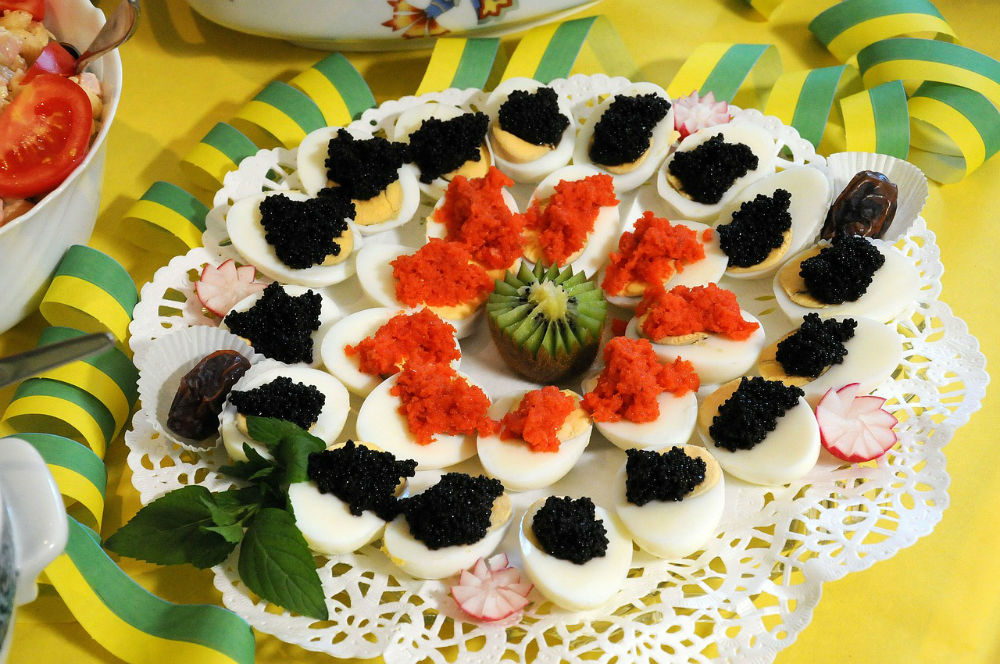Caviar – A Brief History

Caviar is something that has long been loved the world over. Often associated with the wealthy, and also the refined, caviar has a long history in the world and has impacted culture in the same.
Caviar as a word is Turkish in origin, coming from the word khavyar. First seen in English publication around 1591, caviar itself dates back over 250 million years. Though once held in favour only with royalty or the very wealthy, the Americas saw caviar as a common saloon snack during the early 19th century. Due to its natural salty flavour, it was excellent for increasing the sales of beverages for many saloon owners.
Because caviar is so expensively priced today, it is still associated with the very wealthy or affluent. Considered a luxury in most western countries, in the east it is often found much more reasonably priced. Though still expensive it is often served at ritual celebrations in Russia, such as weddings and holiday feasts. Perhaps not surprisingly, caviar can be found in Japan and Hong Kong paired with sushi, and is often cheap in comparison to the rest of the world.
Caviar is commonly something that is gifted as a show of wealth, and is used by the common folk in celebration as a means of experiencing a moment of “rich life”. It is considered to most people as a luxury and non-necessity, known as a delicacy or treat. Often it is considered rude or unkempt to ingest any more than two or three spoonfuls, even when much caviar is available. Traditionally caviar was and still is tasted or tested by placing a small amount on the back of the hand. It is important to note that caviar is also always eaten with a non-metal spoon, with the most common spoon being made of mother-of-pearl and the second most common being manufactured of tortoiseshell or other types of bone.
Complementary foods are often eggs, potatoes or toast points, although caviar is most often enjoyed pure. Caviar can also be found in some types of hors d’oeuvres and the classic Russian combination is caviar and blini, served with sour cream.
Caviar is the eggs or spawn of some 26 species of fish known commonly as the Sturgeon. Sturgeons are well known to be great in size, and have been revered as one of the world’s oldest species of bony fish in the world. Common to the oceans near Eurasia and North America, they are found in subtropical to subarctic waters.
Sturgeon has only been specifically farmed for about the last decade, and even today there exist only 30 or so farms around the world producing 20 tons of caviar per year. Due to the long production time (5-8 years) most farmers can only produce a small amount per farm. It is expected that in the next decade Caviar production will increase to 40 – 50 tons.
Caviar is prepared by killing the Sturgeon and removing its eggs. The eggs are found appearing as shining black pearls or round beads, and are then passed through a fine mesh or filter to remove any remaining tissue or membrane. The eggs are then classified depending on size and colour, with the highest quality often coming from the Beluga, Ossetra, and Sevruga Sturgeon.
Once classified, the eggs are lightly salted, and tend to be approximately four to eight percent salt, with the eggs salted the least often known as the highest in quality.
Although typically caviar is only considered “true” caviar if farmed from the Sturgeon, it can also be farmed from Salmon, Lumpfish, and also Whitefish.
Today’s caviar is found throughout most of the modern world, in both the west and the east, though it is still uncommon for most of society. “Hackleback” caviar from the Shovelnose Sturgeon is a popular, inexpensive product of this industry today and has resulted in caviar being available to more of society. American Paddlefish, a sturgeon cousin, and one of the largest freshwater fish in North America, is also farmed as an alternative source of roe for caviar.
Today, the highest prices are paid for the Beluga, Ossetra, and Sevruga sturgeon varieties of caviar, and these are considered true caviar. Beluga caviar is specifically considered the most expensive and pure form of caviar. Controversy has existed over the Beluga Sturgeon as it is considered endangered. In 2005 the United States enacted a ban on the import of Beluga Caviar as an attempt to save the fish; however, this ban was partially lifted in 2007, allowing 15 percent less import than 2005. Because of this caviar is available today in grades from imitation to the purest of Beluga and is enjoyed occasionally by most of society.








